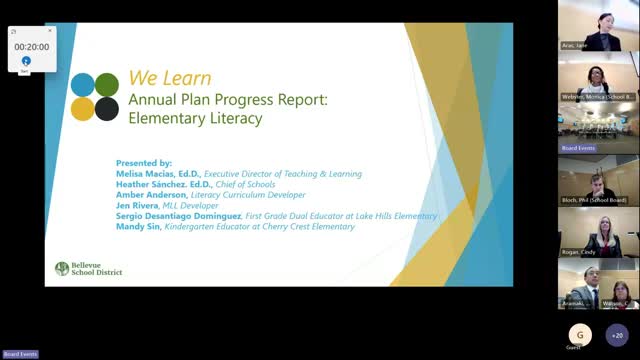Bellevue reports early gains on K–2 decoding tests amid wider literacy gaps; district stresses implementation and interventions
March 23, 2025 | Bellevue School District, School Districts, Washington
This article was created by AI summarizing key points discussed. AI makes mistakes, so for full details and context, please refer to the video of the full meeting. Please report any errors so we can fix them. Report an error »

Bellevue School District officials presented an annual elementary‑literacy update detailing curriculum adoptions and early assessment results and asking the board to focus next steps on targeted interventions for students who remain behind.
Dr. Melissa Macias, executive director of teaching and learning, said the district has adopted a suite of materials grounded in the science of reading — including Heggerty (phonemic awareness), UFLI (phonics/phonemic work, spoken in presentations as “You Fly”), the ARC (American Reading Company) core program, and the El Camino phonics program for dual‑language Spanish instruction. The district is also using LETRS professional development for teachers and has embedded GLAD strategies to support multilingual learners.
Amber Anderson, an elementary curriculum developer, said the district uses DIBELS (grades K–2) and STAR (grades 3–5) as its main screeners three times per year. “We have started to see promising results from DIBELS in our early literacy assessment,” Anderson said, noting the district’s combined K–2 DIBELS results improved from the beginning of year to the middle of year. She added that STAR results have been “statistically flat” overall but show small gains for Hispanic students and English learners.
Teaching staff and curriculum developers highlighted classroom‑level changes tied to fidelity of implementation: explicit and systematic phonics instruction, integration of reading and writing, and daily foundational skills practice. Teachers showed classroom examples and student work and described higher engagement under ARC units (zoology, ecology) and routine structures in phonics lessons.
Presenters acknowledged significant remaining gaps. Amber Anderson said two subgroups — students with disabilities and students who identify as Black or African American — are not showing the progress the district needs, and she called for “very concerted” interventions and systemic supports. The district reported that 30–35 educators were enrolled in or had completed LETRS coursework (an intensive, roughly 60‑hour certification series), and officials said districtwide implementation typically takes three to five years.
Board members asked how the district will scale certified training and reach teacher coverage across all elementary classrooms, how to accelerate catch‑up for older students who missed earlier foundational work, and how the district is engaging families around early screening and dyslexia supports. Presenters outlined outreach events, parent-facing materials, and partnerships with community groups to raise awareness of dyslexia screening and supports.
“The implementation part of things is going really quite remarkably well… Our quantitative outcomes are a bit of a mixed bag,” Dr. Macias told the board. District leaders said they will continue to emphasize fidelity of rollout and to build a districtwide MTSS (multi-tiered system of supports) so students who do not catch up in tier‑1 instruction receive structured interventions.
Dr. Melissa Macias, executive director of teaching and learning, said the district has adopted a suite of materials grounded in the science of reading — including Heggerty (phonemic awareness), UFLI (phonics/phonemic work, spoken in presentations as “You Fly”), the ARC (American Reading Company) core program, and the El Camino phonics program for dual‑language Spanish instruction. The district is also using LETRS professional development for teachers and has embedded GLAD strategies to support multilingual learners.
Amber Anderson, an elementary curriculum developer, said the district uses DIBELS (grades K–2) and STAR (grades 3–5) as its main screeners three times per year. “We have started to see promising results from DIBELS in our early literacy assessment,” Anderson said, noting the district’s combined K–2 DIBELS results improved from the beginning of year to the middle of year. She added that STAR results have been “statistically flat” overall but show small gains for Hispanic students and English learners.
Teaching staff and curriculum developers highlighted classroom‑level changes tied to fidelity of implementation: explicit and systematic phonics instruction, integration of reading and writing, and daily foundational skills practice. Teachers showed classroom examples and student work and described higher engagement under ARC units (zoology, ecology) and routine structures in phonics lessons.
Presenters acknowledged significant remaining gaps. Amber Anderson said two subgroups — students with disabilities and students who identify as Black or African American — are not showing the progress the district needs, and she called for “very concerted” interventions and systemic supports. The district reported that 30–35 educators were enrolled in or had completed LETRS coursework (an intensive, roughly 60‑hour certification series), and officials said districtwide implementation typically takes three to five years.
Board members asked how the district will scale certified training and reach teacher coverage across all elementary classrooms, how to accelerate catch‑up for older students who missed earlier foundational work, and how the district is engaging families around early screening and dyslexia supports. Presenters outlined outreach events, parent-facing materials, and partnerships with community groups to raise awareness of dyslexia screening and supports.
“The implementation part of things is going really quite remarkably well… Our quantitative outcomes are a bit of a mixed bag,” Dr. Macias told the board. District leaders said they will continue to emphasize fidelity of rollout and to build a districtwide MTSS (multi-tiered system of supports) so students who do not catch up in tier‑1 instruction receive structured interventions.
View full meeting
This article is based on a recent meeting—watch the full video and explore the complete transcript for deeper insights into the discussion.
View full meeting
